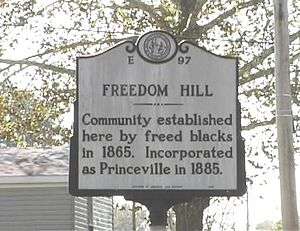Princeville, North Carolina
Princeville is a town in Edgecombe County, North Carolina, and is the oldest town incorporated by African Americans in the United States. It was established by freed slaves after the Civil War and incorporated in 1885. It is part of the Rocky Mount, North Carolina Metropolitan Statistical Area. As of the 2010 census, the town population was 2,082. A 2018 special census recount placed the town's population at 1,939 residents.[5] The town is on the opposite bank of the Tar River from Tarboro. The city of Rocky Mount is 16 miles (26 km) to the west.
Princeville, North Carolina | |
|---|---|
 Location in Edgecombe County and the state of North Carolina. | |
| Coordinates: 35°53′13″N 77°31′14″W | |
| Country | United States |
| State | North Carolina |
| County | Edgecombe |
| Area | |
| • Total | 1.52 sq mi (3.95 km2) |
| • Land | 1.51 sq mi (3.92 km2) |
| • Water | 0.01 sq mi (0.03 km2) |
| Elevation | 30 ft (9 m) |
| Population (2010) | |
| • Total | 2,082 |
| • Estimate (2019)[2] | 1,926 |
| • Density | 1,272.97/sq mi (491.45/km2) |
| Time zone | UTC-5 (Eastern (EST)) |
| • Summer (DST) | UTC-4 (EDT) |
| ZIP code | 27886 |
| Area code(s) | 252 |
| FIPS code | 37-53840[3] |
| GNIS feature ID | 1022085[4] |
| Website | townofprinceville |

History
In July 2012, the State Treasurer's Office took control of the books for financially strapped Princeville, only the fifth time the state has taken over for a local municipality since the 1930s. Princeville has been taken over twice – the state also assumed control of its books in 1997.[6]
Princeville experienced severe flooding in September 1999 by the Cape Verde-type Hurricane Floyd[7] and in October 2016 by the Category 5 Atlantic Hurricane Matthew.[8]
Princeville School was listed on the National Register of Historic Places in 2001.[9]
Geography
Princeville is located at 35°53′13″N 77°31′14″W (35.886974, -77.520584).[10]
According to the United States Census Bureau, the town has a total area of 1.53 square miles (3.95 km2), of which 1.51 square miles (3.92 km2) is land and 0.01 square miles (0.03 km2), or 0.69%, is water.[5]
Demographics
| Historical population | |||
|---|---|---|---|
| Census | Pop. | %± | |
| 1890 | 428 | — | |
| 1900 | 552 | 29.0% | |
| 1910 | 627 | 13.6% | |
| 1920 | 562 | −10.4% | |
| 1930 | 614 | 9.3% | |
| 1940 | 818 | 33.2% | |
| 1950 | 919 | 12.3% | |
| 1960 | 797 | −13.3% | |
| 1970 | 654 | −17.9% | |
| 1980 | 1,508 | 130.6% | |
| 1990 | 1,652 | 9.5% | |
| 2000 | 940 | −43.1% | |
| 2010 | 2,082 | 121.5% | |
| Est. 2019 | 1,926 | [2] | −7.5% |
| U.S. Decennial Census[11] | |||
The 2000 census data reflect the town shortly after 1999's Hurricane Floyd; a 2004 census recount had been conducted, doubling the town's reported population (see above).
As of the census[3] of 2000, there were 940 people, 346 households, and 255 families residing in the town. The population density was 590.5 people per square mile (228.3/km2). There were 761 housing units at an average density of 478.0 per square mile (184.8/km2). The racial makeup of the town was 97.45% African American, 2.23% White, 0.11% Asian, and 0.21% from two or more races. Hispanic or Latino of any race were 0.64% of the population.
There were 346 households, out of which 27.2% had children under the age of 18 living with them, 40.5% were married couples living together, 27.5% had a female householder with no husband present, and 26.3% were non-families. 24.3% of all households were made up of individuals, and 10.1% had someone living alone who was 65 years of age or older. The average household size was 2.72 and the average family size was 3.21.
In the town, the population was spread out, with 25.9% under the age of 18, 8.6% from 18 to 24, 24.9% from 25 to 44, 29.9% from 45 to 64, and 10.7% who were 65 years of age or older. The median age was 38 years. For every 100 females, there were 81.5 males. For every 100 females age 18 and over, there were 76.9 males.
The median income for a household in the town was $31,667, and the median income for a family was $35,625. Males had a median income of $23,281 versus $19,886 for females. The per capita income for the town was $12,603. About 14.0% of families and 17.6% of the population were below the poverty line, including 30.9% of those under age 18 and 20.7% of those age 65 or over.
References
- "2019 U.S. Gazetteer Files". United States Census Bureau. Retrieved July 27, 2020.
- "Population and Housing Unit Estimates". United States Census Bureau. May 24, 2020. Retrieved May 27, 2020.
- "U.S. Census website". United States Census Bureau. Retrieved 2008-01-31.
- "US Board on Geographic Names". United States Geological Survey. 2007-10-25. Retrieved 2008-01-31.
- "Geographic Identifiers: 2010 Demographic Profile Data (G001): Princeville town, North Carolina". U.S. Census Bureau, American Factfinder. Retrieved March 8, 2016.
- "With Princeville a pauper, state takes over town's books". WRAL. Retrieved March 8, 2016.
- Princeville and the environmental landscape of race Retrieved December 9, 2016
- Black History and Floods Intertwine NYTimes, December 9, 2016
- "National Register Information System". National Register of Historic Places. National Park Service. July 9, 2010.
- "US Gazetteer files: 2010, 2000, and 1990". United States Census Bureau. 2011-02-12. Retrieved 2011-04-23.
- "Census of Population and Housing". Census.gov. Retrieved June 4, 2015.